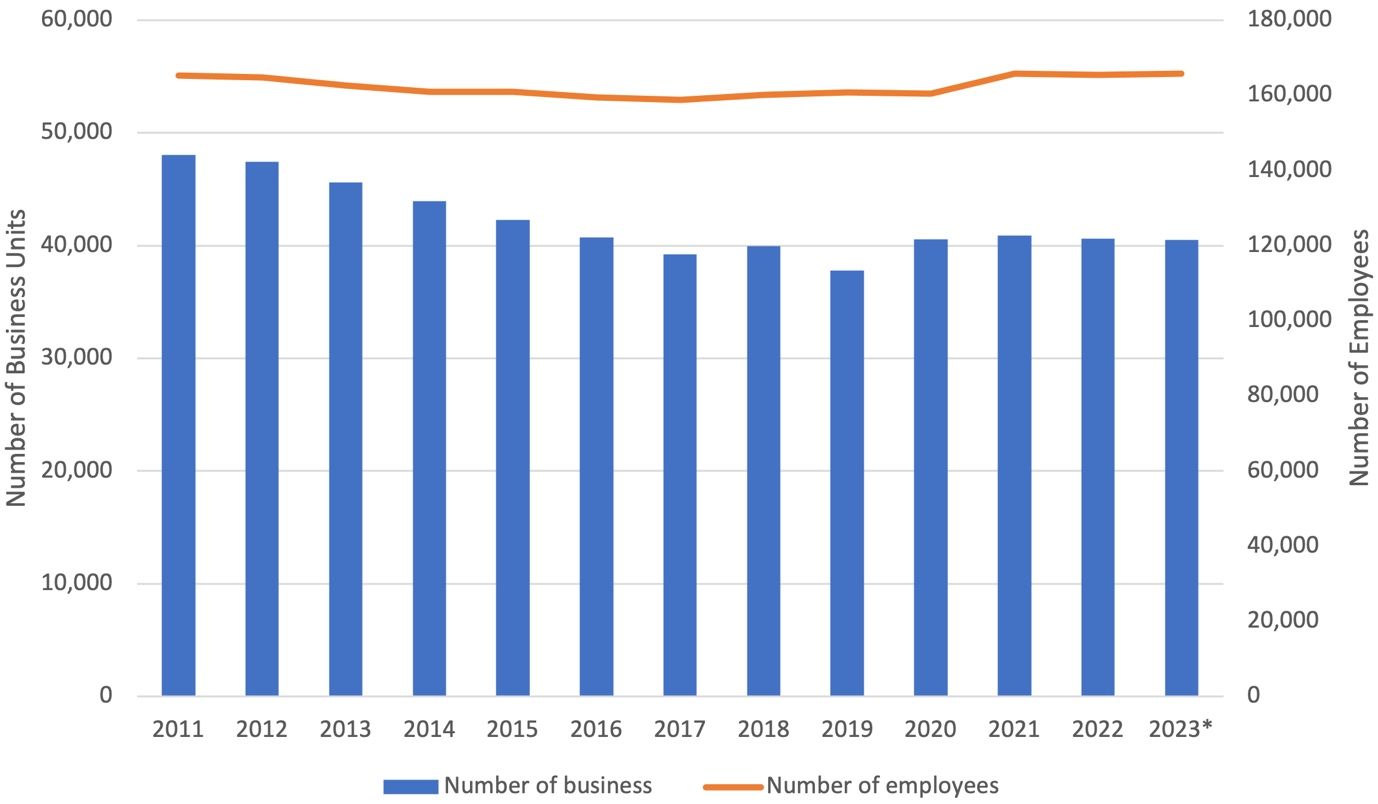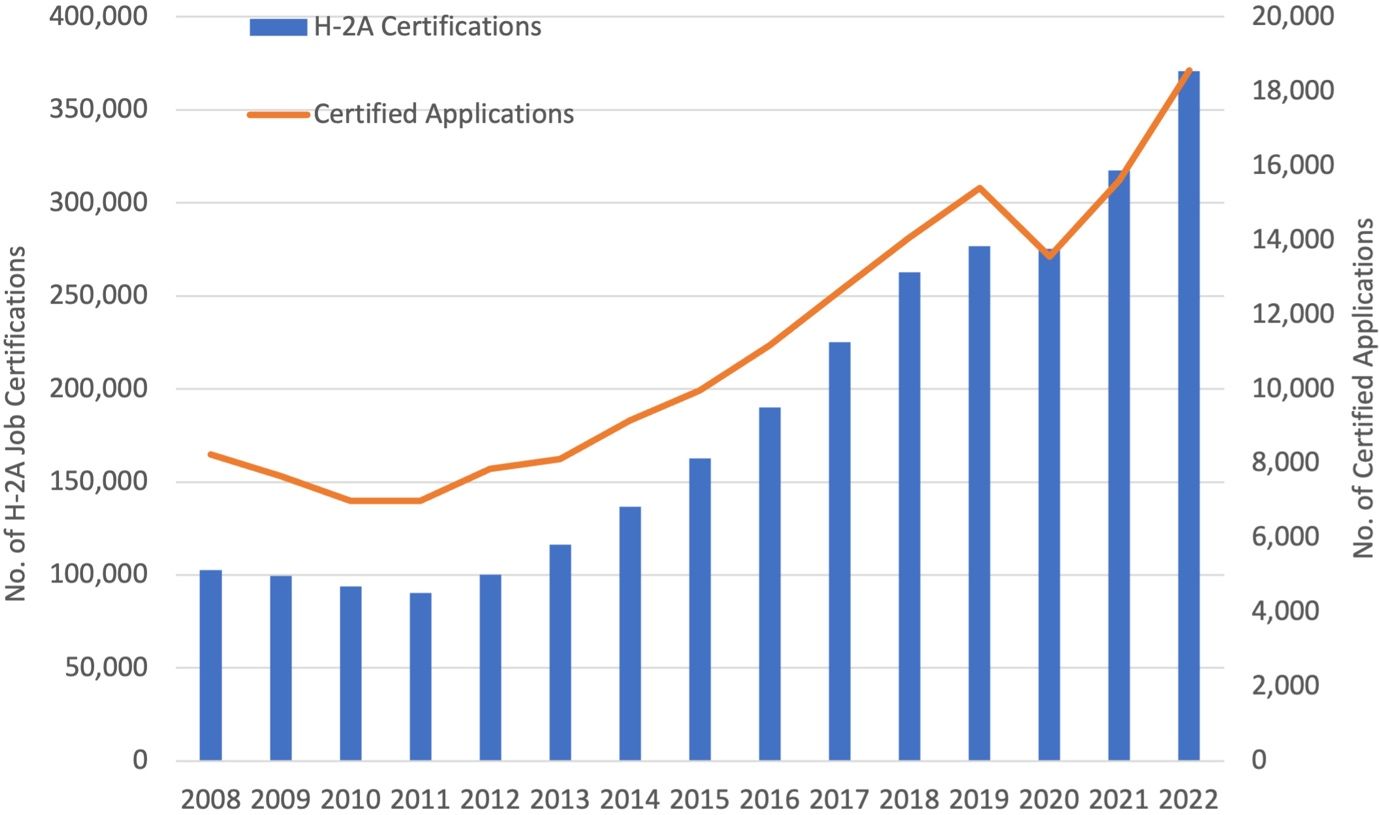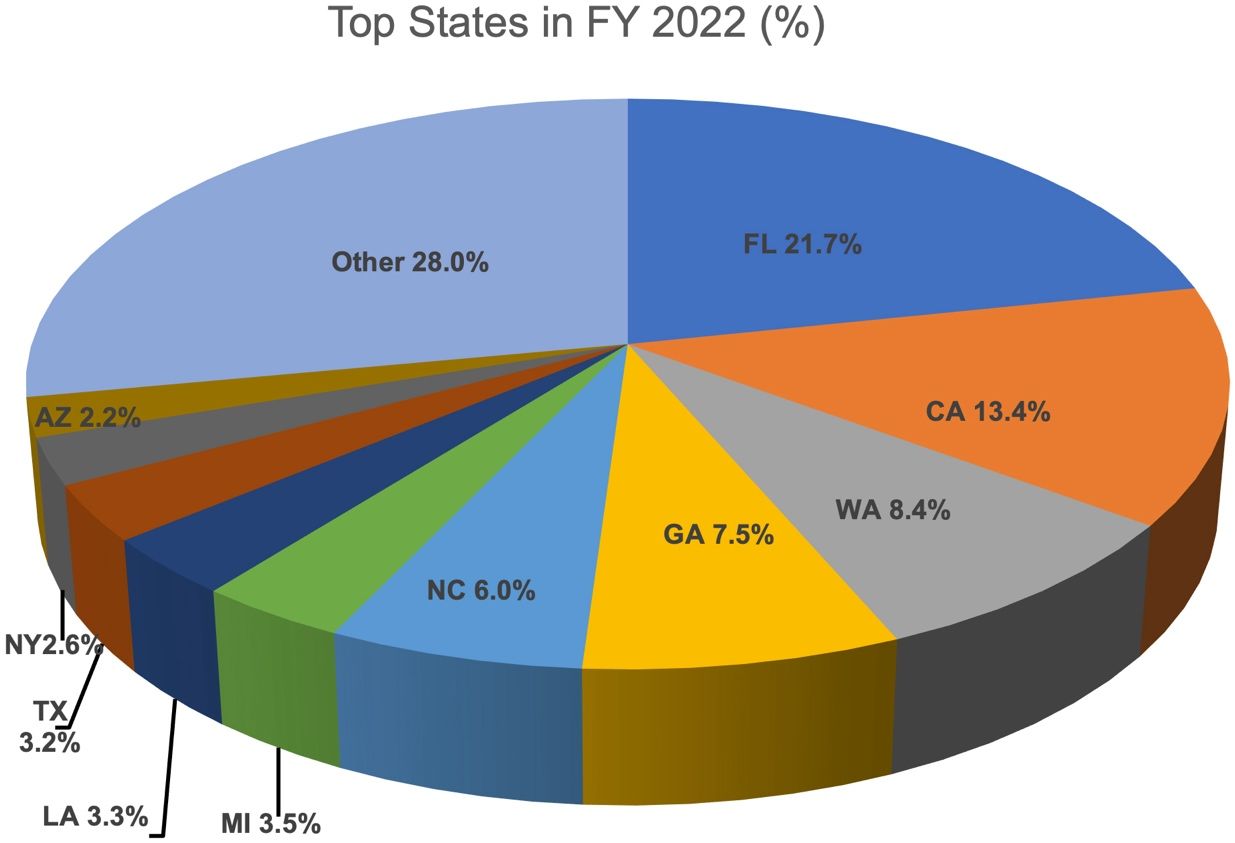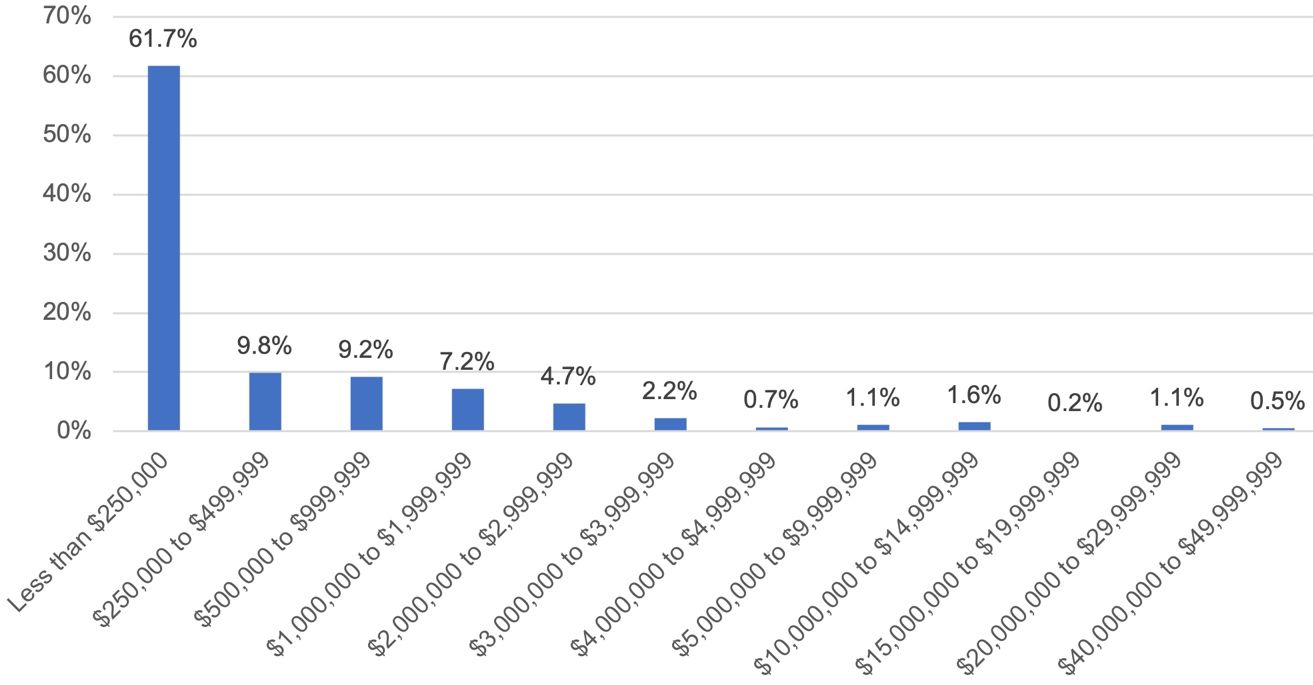Introduction
For several decades, the agricultural industry in the United States has depended heavily on immigrant farm labor, particularly in the specialty crop sector, where tasks like harvesting require a lot of labor. A recent report by Hernandez and Gabbard (2018) shows that a significant majority of farmworkers (75%) are citizens of other countries, with 69% of them from Mexico. Almost half of all farmworkers in the United States (49%) are not authorized to work in the country. Most farmworkers were employed in labor-intensive production, with 37% working in vegetables, 32% in fruit and nut crops, and 19% in ornamental horticulture. The importance of immigrant labor in meeting the demand for workers in the nursery and floriculture production sector—North American Industry Classification System (NAICS) 11142—has been further highlighted with the considerable economic growth in that sector in recent years. According to Hall et al. (2020), the total economic contributions of this sector reached $28.69 billion in 2018. As of 2022, the IBISWorld Industry Report (Rose 2023) shows that the sector has over 40,500 business units and provides employment for more than 165,000 individuals (Figure 1).

Credit: UF/IFAS; data from IBISWorld database. *Number of business units and employees for 2023 were forecasted by IBISWorld Industry Report 11142 Plant & Flower Growing in the US (Rose 2023).
The ornamental horticulture industry relies heavily on workers who perform a range of tasks, including pruning, fertilizing, scouting, spraying pesticides, planting, harvesting, packing, and weeding. Because horticultural products are perishable, a skilled and accessible labor supply is crucial for the industry's continued growth and stability. However, there has been a decline in the number of immigrant workers in recent years. This could be due to various factors, including a decrease in migration from Mexico (Passel and Cohn 2019), changes in the farm labor workforce (Fan et al. 2015; Martin 2017), and the availability of job opportunities in non-agricultural sectors (Taylor et al. 2012; Zahniser et al. 2012). Strict border control and local immigration enforcement measures may also be contributing to the reduction in the supply of farm workers (Kostandini et al. 2014). As labor shortages in the agricultural industry continue to be a pressing issue for growers, the H-2A program is becoming an increasingly important source of temporary agricultural workers for growers in the United States. The H-2A program allows agricultural employers who anticipate a shortage of domestic workers to hire foreign workers on a temporary or seasonal basis.
Although the nursery and greenhouse growers’ industry (NAICS 1114) uses H-2A workers to a lesser extent compared to other specialty crop sectors, there has been a notable twofold increase in its utilization of H-2A workers. The number of certifications has steadily increased from 9,123 in 2010 to 20,770 in 2019, according to Castillo et al. (2021). This publication offers an overview of the increasing demand for H-2A workers in the ornamental horticulture industry, examines challenges faced by growers, and explores the underlying factors affecting workers’ participation in the H-2A program. The insights presented in this publication are relevant for the industry stakeholders, urging them to closely monitor the changes in immigration policies and labor regulations, including the H-2A program and to adjust labor management practices accordingly. To address the challenge of labor availability and remain competitive in the marketplace, ornamental growers must carefully manage their labor costs and adapt their labor management practices. Effective strategies could include hiring H-2A workers, reducing labor hours, adopting more mechanization, or selecting crops that require less labor input.
Increasing demand for H-2A workers
Under the H-2A program, growers must demonstrate that there are not enough US workers who are able, willing, qualified, and available to fulfill the positions, and that hiring H-2A workers will not adversely affect the wages and working conditions of similarly employed US workers. The process starts with the grower requesting certification from the United States Department of Labor (DOL), which confirms these conditions. If the DOL certifies the request, the employer can then petition for foreign workers to enter the United States through the United States Citizenship and Immigration Services (USCIS). Additionally, employers must adhere to standards for fair wages and working conditions and provide transportation, housing, and meals for H-2A workers during their employment period. Despite the administrative burden, strict recruitment timelines, and associated cost for housing and transportation, as shown in Figure 2, the number of H-2A agricultural guest worker applications increased significantly between 2008 and 2022 (240%), as did the number of H-2A job certifications (360%). In 2022, greenhouse and nursery growers (NAICS 1114) secured nearly 21,000 H-2A jobs (of 370,907 jobs), accounting for 6% of all certified H-2A jobs.

Credit: UF/IFAS adapted from the U.S. Department of Labor, Office of Foreign Labor Certification (https://www.dol.gov/agencies/eta/foreign-labor/performance)
H-2A employment varies by state, industry, employer size, and type of farm employer (labor contractor, individual farmer, or growers’ association). Farm labor contractors (FLCs) are intermediaries that recruit workers and supply them to farms for a fee (Taylor and Charlton 2018). FLCs simplify the process of recruiting and managing farmworkers and may help fixed-situs employers share the risks associated with hiring unauthorized workers. It is common for FLCs to provide H-2A workers to multiple farms, allowing these workers to be employed on several farms during their time in the United States. More than half of the recent growth in H-2A certifications comes from FLCs. According to Castillo et al. (2022), the FLC share of H-2A employment has increased from 13% in 2007 to 44% in 2020, due to their effectiveness in recruiting productive workers and ensuring their consistent employment throughout their stay in the United States, which helps offset H-2A transportation and housing expenses through enhanced productivity.
In 2022, the majority of H-2A workers were hired in ten states, including Florida, California, Washington, Georgia, North Carolina, Louisiana, Texas, New York, and Arizona. These ten states accounted for over 70% of all H-2A workers nationwide (as shown in Figure 3). Although California has historically faced regulatory hurdles and costs that have limited its use of the H-2A program, the state's reliance on it has grown in recent years. Meanwhile, the recent increasing Adverse Effect Wage Rate (AEWR) in many states has made H-2A labor more expensive per hour. These trends may have broader implications for the agriculture industry in California and other parts of the country. Therefore, stakeholders should adapt to these changing trends and adjust their strategies as needed.

Credit: UF/IFAS, adapted from the U.S. Department of Labor, Office of Foreign Labor Certification ()
Evidence from National Green Industry Surveys
The findings from our study, which utilized data from the 2014 and 2019 National Green Industry Surveys, shed light on the factors that influence ornamental growers' decisions regarding H-2A worker hiring. The National Green Industry Survey collected detailed nation-wide information on the production and marketing practices of ornamental plant growers and dealer firms at five-year intervals. After excluding dealer firms not involved in greenhouse and nursery production, our analysis focused on 2,390 observations, including 1,532 growers from the 2014 survey and 1,398 growers from the 2019 survey. Among them, 447 growers were from Florida. Relatively small firms (i.e., annual sales value less than $250,000) account for 62% of the survey respondents. The distribution of Florida growers by the annual sales value is depicted in Figure 4.

Credit: UF/IFAS from 2014 and 2019 National Green Industry Surveys
The main factors affecting growers' decisions are their home states' implementation of the 287(g) program and industry employment and wage payment trends. As part of the U.S. Immigration and Nationality Act, the 287(g) program authorizes collaboration between U.S. Immigration and Customs Enforcement (ICE) and state/local law enforcement agencies to perform specific immigration officer functions. (Specifically, the Jail Enforcement Model sub-program identifies and processes removable noncitizens with criminal charges. Further, the Warrant Service Officer sub-program empowers trained state and local officers to serve administrative warrants on noncitizens in their agency's jail. Participating jurisdictions sign a memorandum of agreement with U.S. Immigration and Customs Enforcement to establish their involvement.) Our results suggest growers are more likely to participate in the H-2A program if their home states have implemented the restrictive 287(g) program. However, an increase in industry employment of domestic workers is likely to discourage participation in the H-2A program, while a rise in industry wage costs may encourage participation. The study also found that larger growers are more likely to participate in the H-2A program, as increasing farm sales value only marginally increases the probability of program participation. This suggests that the current H-2A program may present a challenge for smaller growers but be beneficial for larger growers. It will be important to continue monitoring these factors to ensure that the H-2A program is meeting the needs of the ornamental industry.
Discussions and Conclusion
The results of this study highlight the importance of growers keeping up to date with changes in labor regulations and policies, especially those related to the H-2A program. While small US horticultural operations do not require hired workers, larger operations (i.e., with annual sales value of $200,000 and more) are affected by the evolving US immigration policies that are impacting the availability of labor. Growers of specialty crops, such as ornamental plants, fruits, and vegetables, in states like California, Florida, Washington, and Georgia, have increasingly turned to the H-2A program for labor. The current H-2A program's procedural requirements and pre-employment costs, such as housing and transportation, may discourage small and medium-sized businesses in the ornamental horticultural industry from recruiting H-2A workers, as many of them are small and family-owned. Additionally, the increase in AEWR means that labor costs are higher, which makes it more challenging for growers to use the H-2A program. State nursery and greenhouse growers' associations can provide services and help employers streamline the hiring process. These groups can assist with filing for H-2A visas and can help educate producers on laws and best practices, including compliance with housing and transportation requirements.
References
Castillo, M., S. Simnitt, G. Astill, and T. Minor. 2021. Examining the Growth in Seasonal Agricultural H-2A Labor. EIB-226, U.S. Department of Agriculture, Economic Research Service. https://www.ers.usda.gov/webdocs/publications/102015/eib-226.pdf?v=7926.5 [accessed 15 July 2023]
Castillo, M., P. Martin, and Z. Rutledge. 2022. The H-2A Temporary Agricultural Worker Program in 2020. EIB-238, U.S. Department of Agriculture, Economic Research Service. https://www.ers.usda.gov/webdocs/publications/104606/eib-238.pdf?v=7878.3 [accessed 14 July 2023]
Fan, M., S. Gabbard, A. Alves Pena, and J. M. Perloff. 2015. “Why do fewer agricultural workers migrate now?” American Journal of Agricultural Economics 97 (3): 665–679. https://doi.org/10.1093/ajae/aau115
Hall, C. R., A. W. Hodges, H. Khachatryan, and M. A. Palma. 2020. “Economic Contributions of the Green Industry in the United States in 2018.” Journal of environmental Horticulture 38 (3): 73–79. https://doi.org/10.24266/0738-2898-38.3.73
Hernandez, T., and S. Gabbard. 2018. Findings from the National Agricultural Workers Survey (NAWS) 2015–2016: A Demographic and Employment Profile of United States Farmworkers. Research Report No. 13. https://www.dol.gov/sites/dolgov/files/ETA/naws/pdfs/NAWS_Research_Report_13.pdf. [accessed 11 Oct 2022]
Kostandini, G., E. Mykerezi, and C. Escalante. 2014. “The Impact of Immigration Enforcement on the U.S. Farming Sector.” American Journal of Agricultural Economics 96 (1): 172–192. https://doi.org/10.1093/ajae/aat081
Martin, P. 2017. Immigration and Farm Labor: From Unauthorized to H-2A for Some? Migration Policy Institute, Washington, DC. https://www.migrationpolicy.org/sites/default/files/publications/Martin-ImmigrationAgricultureH2AWorkers-FINAL.pdf. [accessed 11 Oct 2022].
Passel, J. S., and D. Cohn. 2019. “Mexicans decline to less than half the U.S. unauthorized immigrant population for the first time.” Pew Research Center, 12. https://www.pewresearch.org/fact-tank/2019/06/12/us-unauthorized-immigrant-population-2017/. [accessed 11 Oct 2022].
Rose, A. 2023. Plant & Flower Growing in the US. Industry Report 11142. Retrived from IBISWorld database. [accessed 05 Mar 2023]
Taylor, J. E., D. Charlton, and A. Yúnez‐Naude. 2012. “The End of Farm Labor Abundance.” Applied Economic Perspectives and Policy 34 (4): 587–598. https://doi.org/10.1093/aepp/pps036
Taylor, J. E., and D. Charlton. 2018. The Farm Labor Problem: A Global Perspective, Academic Press.
Zahniser, S., T. Hertz, M. T. Rimmer, and P. B. Dixon. 2012. The Potential Impact of Changes in Immigration Policy on U.S. Agriculture and the Market for Hired Farm Labor: A Simulation Analysis. U.S. Department of Agriculture Economic Research Service Economic Research Report. No. 135. Washington, DC.